Atlantic Salmon Stocking – Fun & Rewarding
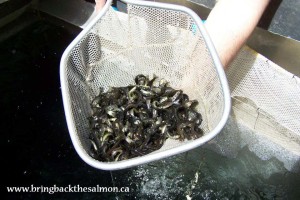
A net full of Atlantic salmon fry.
Photo courtesy of the Lake Ontario Atlantic Salmon Restoration Program.
“The important thing is to keep an eye on your kids and keep them dry.”
That was the basic instruction given to myself, Darrell, and the rest of the volunteers helping with the Atlantic salmon stocking on May 1st. As part of the amazing and far-reaching Lake Ontario Atlantic Salmon Restoration Program, a group of Grade 6 students from Belfountain PS were spending a day on the water, learning, and releasing fish. Their involvement with the Classroom Hatchery part of the program had begun last fall and, as I would find out throughout the morning, they had learned a lot, and had a lot of fun doing it.
Each volunteer was assigned to a group of three students and, after trying to deck a few of them out in waders, it became obvious that keeping them dry would be a difficult task. Between leaky waders and the rather odd desire to dunk waders into the river and fill them with water, there were certainly a few wet students by the end of the morning. However, it did nothing to ‘dampen’ everyone’s spirits and it was probably the most entertaining and enjoyable day of fish stocking that I have experienced.
I was lucky enough to end up with three fantastic students. After failing to secure non-leaky waders for two of them, we decided that one student would wear waders and release fish with me, while the others would carry the bag of fish down to the river. It was a beautiful day to be in the Forks of the Credit and the sunshine made it feel more like mid-July than the beginning of May. Picking up our bag of fish at the truck, we would walk along the river until we found our flag at the shoreline, and release our fish. Four bags per group went by rather fast and it wasn’t long before 30,000 Atlantic salmon fry were in the water and starting the next phase of their journey.
One of my students had encountered a pair of leaky waders and quickly decided to stay on shore afterwards, while telling me about an outing in the fall where he was not so lucky and ended up having having to borrow a dry pair of pants from a female classmate. Darrell’s students had no qualms about getting wet. In fact, I think all three were soaked by the end of the morning. I guess he didn’t listen to the basic instructions very well!
The outing with the students was by far the most fun I had that week, but I was also lucky enough to participate in two other stocking days with the program, all along the Credit River and its tributaries. Since Darrell is normally stuck at work when the events are on, I was thrilled when he ended up with a few days off and was able to attend some of the dates with me. I had given him a brief overview of what would happen based on my experience from last year and, like anything involving water and fish, he took to it right away.
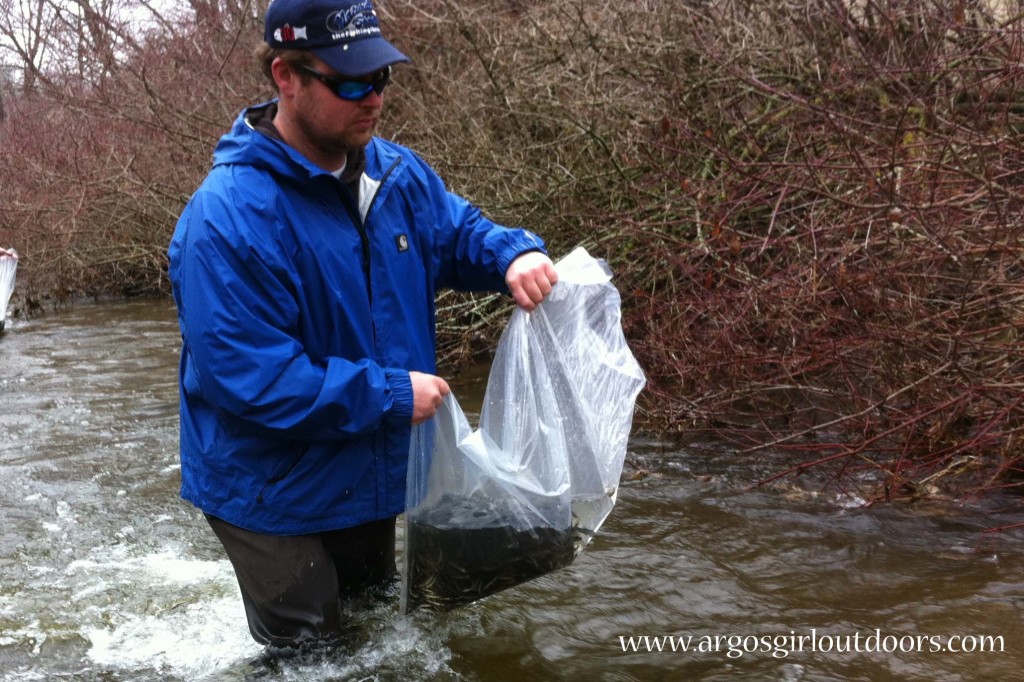
Darrell finally got to experience the joy of releasing some Atlantic salmon. This is his ‘business’ face, he really was happy, I swear.
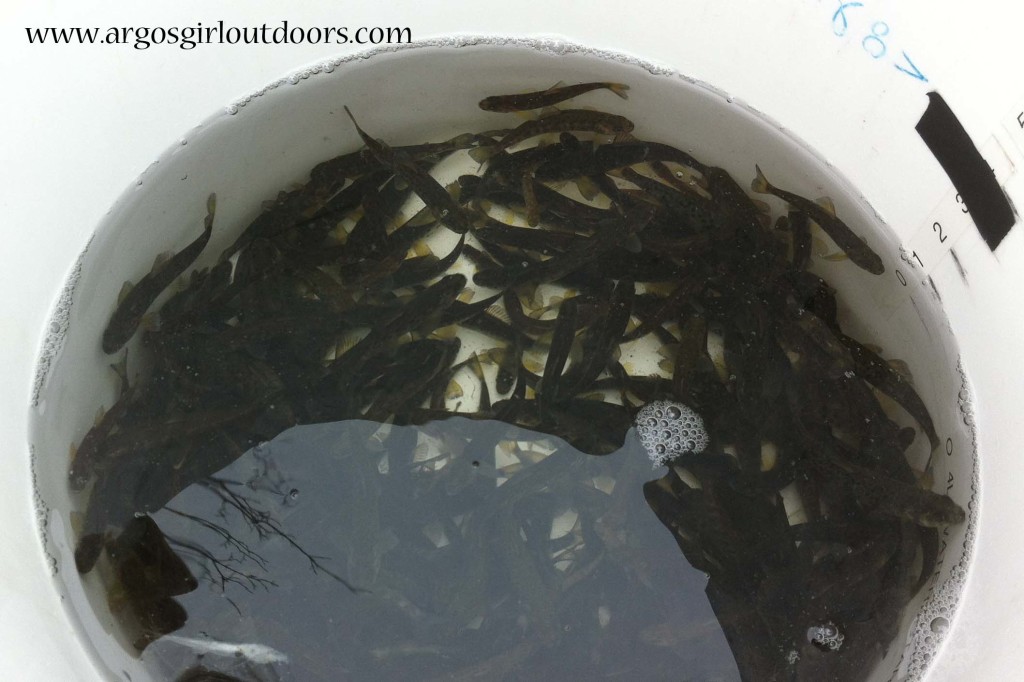
Fish in a bucket. If you know how much each fry weighs, then by adding to a certain amount of water you can get the correct number of fish in each bag.
The Atlantic salmon program provides amazing new opportunities for fisheries research. Since little was known about the methods and effects of re-introducing the extirpate Atlantic salmon, this program is an example of continual adaptation and assessment. For one thing, the Atlantics do best when dispersed at a certain density during stocking. Traditional methods of stocking, such as backing the truck up to the river and emptying the fish out through a hose, do not work well for these fish, which is why we bag a certain number of fish at a time and spread them out over a distance, placing them into riffles – areas with faster, shallower water, and lots of rock.
Many monitoring methods are now in place to track the success of this program. Electrofishing, microchip implantation, and redd surveys are just a few of the methods in place. One of the neatest methods I only learned about during this year’s stocking is the use of a rotary screw trap. This trap basically funnels fish into it and allows for the monitoring of Atlantic salmon as they migrate downstream. By capturing fish along their migration, staff working with the Atlantic salmon program are able to work out factors such as how long the fish are staying in the rivers, what the survival rate is, and how fast they grow. Since other fish are trapped as well, it gives researchers a way of tracking and studying many of the fish populations within a river. The amount information that can be learned from this program absolutely astonishes and excites me.
Aside from the scientific data collection and data crunching part of the Bring Back The Salmon program, there are a plenitude of benefits. Through the classroom hatcheries it gets kids involved in nature and the outdoors, and teaches them about responsibility and stewardship. Through various stream restoration projects it improves the health of the ecosystem, benefiting everything living within and around that river. It also provides the public, like myself, a chance to get out and help at various volunteer activities, whether it’s fish stocking, tree planting, or garbage cleanup. At the last stocking date I participated in, I was heartened to see that one mother thought it was such an important experience that she brought her daughter along. She told me that she felt her daughter would greatly benefit from getting outside and being involved in such a worthwhile program.
If nothing else, I hope the message you take away from this post is that it’s fun to get involved. Fish stocking, in particular, is an exciting activity to participate in. You don’t need to bring any special equipment with you as waders can be provided, and it’s not a difficult activity. Just dress appropriately, pack a lunch, and prepare for an amazing day.
If you would like to get involved with the Lake Ontario Atlantic Salmon Restoration Program (also known as the Bring Back the Salmon program), follow them on Facebook for more information, or visit the website at www.bringbackthesalmon.ca.
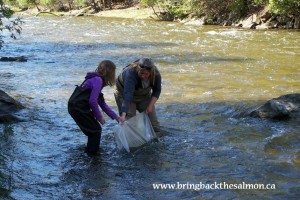
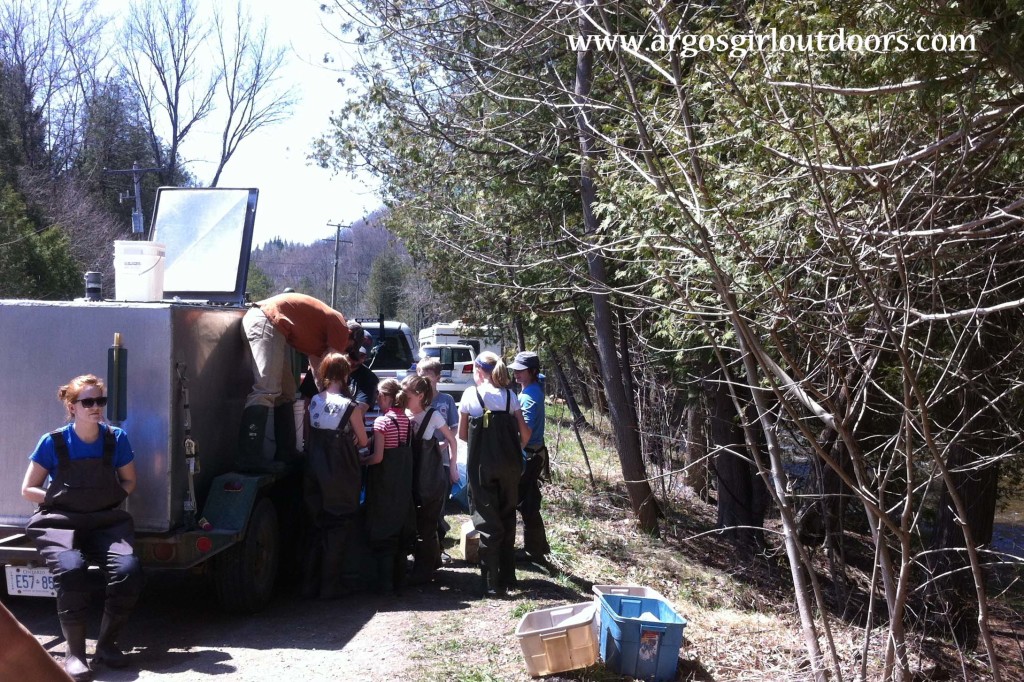




“The Important thing is to keep an eye on your kids and keep them dry”… advice for the ages!
LOL such simple advice and yet, so difficult to execute! Thanks for visiting!